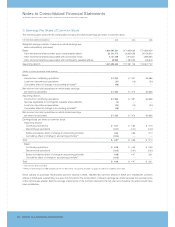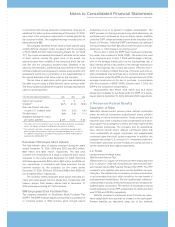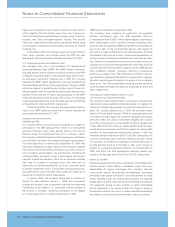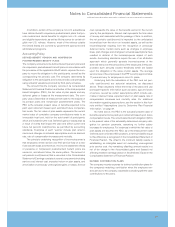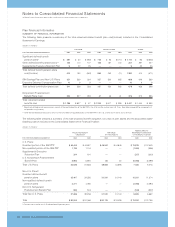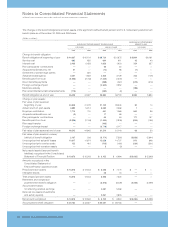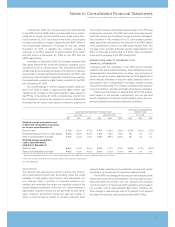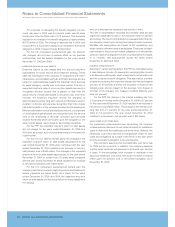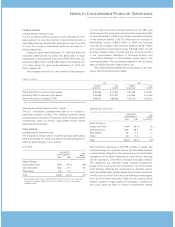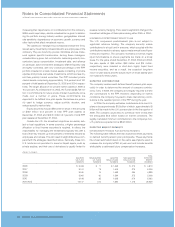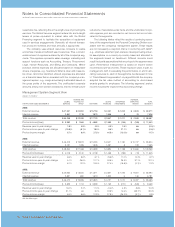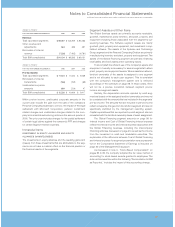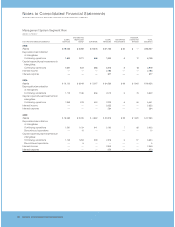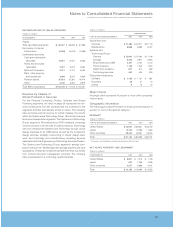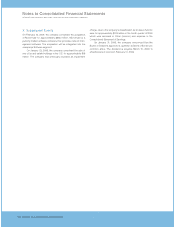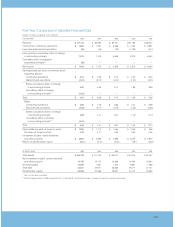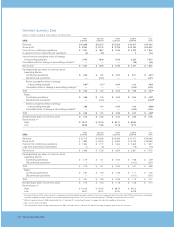IBM 2005 Annual Report Download - page 93
Download and view the complete annual report
Please find page 93 of the 2005 IBM annual report below. You can navigate through the pages in the report by either clicking on the pages listed below, or by using the keyword search tool below to find specific information within the annual report.
NotestoConsolidatedFinancialStatements
INTERNATIONALBUSINESSMACHINESCORPORATION ANDSUBSIDIARYCOMPANIES
92_ NotestoConsolidatedFinancialStatements
Forpurposes ofcalculatingthebenefitobligation,thedis-
count rate used in 2005 was 5.5 percent which was 25 basis
pointslowerthanthe2004rateof5.75percent.Thisdecrease
resulted in anincreaseinthebenefitobligationofapproximately
$1,272 million in2005.Thechangeindiscountratein2004from
6.0percentto5.75percentresultedinanincreasein the benefit
obligationin2004ofapproximately$1,193million.
FortheU.S.nonpensionpostretirementplan, the discount
rate changes did not have a material effect on net periodic
cost/(income) and the benefit obligation for the years ended
December31,2005and 2004.
EXPECTEDRETURNONPLANASSETS
Expected returns on plan assets take into account long-term
expectations for future returns and investment strategy. These
ratesaredevelopedbythecompanyinconjunctionwithexter-
naladvisors, are calculatedusinganarithmeticaverageand are
testedforreasonablenessagainstthehistoricalreturnaverage
by asset category, usually over a ten-year period. The use of
expectedlong-termratesofreturnonplanassetsmayresultin
recognized pension income that is greater or less than the
actualreturnsofthoseplanassetsinanygivenyear.Overtime,
however, the expected long-term returns are designed to
approximatetheactuallong-termreturnsandthereforeresultin
apatternofincomeandexpenserecognitionthatmoreclosely
matchesthepatternoftheservicesprovidedbytheemployees.
Differencesbetweenactualandexpectedreturns,acomponent
ofunrecognizedgains/losses, arerecognized overtheservice
lives of the employees in the plan, provided such amounts
exceedthresholdswhicharebasedupontheobligationorthe
valueofplanassets,asprovidedbyaccountingstandards.
ForthePPP,theexpectedlong-termreturnonplanassets
did not change for the years ended December 31, 2005 and
2004and,asaresult,hadnoincrementalimpactonnetperiodic
cost/(income).
Forthenon-U.S.definedbenefitplans,thechangesinthe
expectedlong-term returnon plan assetsassumptions for the
yearended December 31,2005 whencomparedwith theyear
endedDecember 31, 2004resultedin an increasein netperi-
odicpensioncostof$140 million.Thechangesintheexpected
long-termreturnonplanassetsassumptionsfortheyearended
December31,2004forcertainnon-U.S.planswhencompared
withtheyearendedDecember31,2003resultedinanincrease
innetperiodicpensioncostof$54million.
For the U.S. nonpension postretirement benefit plan, the
companymaintainsanominal,highlyliquidtrustfundbalanceto
ensure payments are made timely. As a result, for the years
ended December 31, 2005 and 2004, the expected long-term
returnonplanassetsandtheactualreturnonthoseassetswere
notmaterial.
RATEOFCOMPENSATIONINCREASESANDMORTALITYRATE
Therateofcompensationincreasesandmortalityratesarealso
significant assumptions used in the actuarial model for pension
accounting.Therateofcompensationincreasesisdeterminedby
thecompany,baseduponitslong-termplansforsuchincreases.
Mortality rate assumptions are based on life expectancy and
deathratesfordifferenttypesofparticipants.Therewasnosignif-
icantimpacttotheprojectedbenefitobligationortonetperiodic
costasaresultofchangestotherateofcompensationincreases
or to mortality rate assumptions during the years ended
December31,2005and2004.
INTERESTCREDITINGRATE
BenefitsforcertainparticipantsinthePPParecalculatedusing
acashbalanceformula.Anassumptionunderlyingthisformula
isaninterestcreditingrate,whichimpactsbothnetperiodiccost
andtheprojected benefitobligation.Thisassumptionprovides
abasisforprojectingtheexpectedinterestratethatparticipants
willearnonthebenefitsthattheyare expectedtoreceiveinthe
following year and are based on the average, from August to
October of the one-year U.S. Treasury Constant Maturity yield
plusonepercent.
Forthe PPP, the changeinthe interest creditingrate from
2.3percentfortheyearendedDecember31,2004to3.1 percent
fortheyearendedDecember31,2005resultedinanincreaseto
netperiodiccostof$55million. Thechangeintheinterestcred-
iting rate from 2.7 percent for the year ended December 31,
2003 to 2.3 percent for the year ended December 31, 2004
resultedin a decreasetonetperiodiccostof$20 million.
HEALTHCARECOSTTRENDRATE
For nonpension postretirement plan accounting, the company
reviewsexternaldataanditsownhistoricaltrendsforhealthcare
coststodeterminethehealthcarecosttrendrates. However, the
healthcare cost trend rate has an insignificant effect on plan
costsandobligations asaresultofthetermsoftheplanwhich
limitthecompany’sobligationtotheparticipants.
Thecompanyassumesthatthe healthcarecost trendrate
for 2006 will be 9 percent. In addition, the company assumes
thatthesametrendratewilldecreaseto5percentoverthenext
4 years. A one-percentage point increase or decrease in the
assumedhealthcarecost trendratewouldnothavea material
effect upon net periodic cost or the benefit obligation as of
December31,2005.


